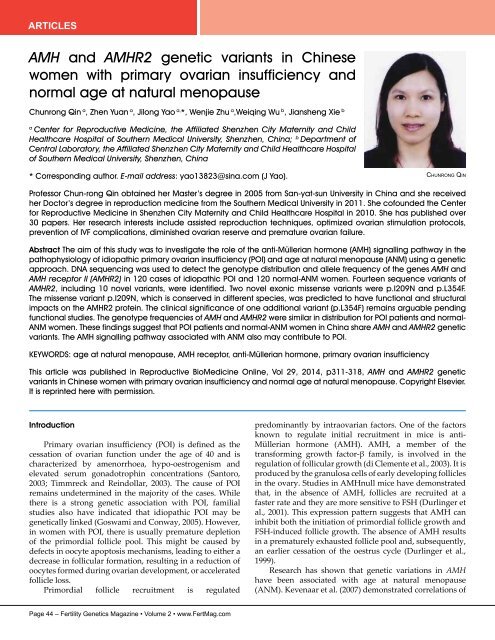FERTILITY GENETICS
TCqTZH
TCqTZH
Create successful ePaper yourself
Turn your PDF publications into a flip-book with our unique Google optimized e-Paper software.
ARTICLES<br />
AMH and AMHR2 genetic variants in Chinese<br />
women with primary ovarian insufficiency and<br />
normal age at natural menopause<br />
Chunrong Qin a , Zhen Yuan a , Jilong Yao a, *, Wenjie Zhu a ,Weiqing Wu b , Jiansheng Xie b<br />
a<br />
Center for Reproductive Medicine, the Affiliated Shenzhen City Maternity and Child<br />
Healthcare Hospital of Southern Medical University, Shenzhen, China; b Department of<br />
Central Laboratory, the Affiliated Shenzhen City Maternity and Child Healthcare Hospital<br />
of Southern Medical University, Shenzhen, China<br />
* Corresponding author. E-mail address: yao13823@sina.com (J Yao).<br />
Chunrong Qin<br />
Professor Chun-rong Qin obtained her Master’s degree in 2005 from San-yat-sun University in China and she received<br />
her Doctor’s degree in reproduction medicine from the Southern Medical University in 2011. She cofounded the Center<br />
for Reproductive Medicine in Shenzhen City Maternity and Child Healthcare Hospital in 2010. She has published over<br />
30 papers. Her research interests include assisted reproduction techniques, optimized ovarian stimulation protocols,<br />
prevention of IVF complications, diminished ovarian reserve and premature ovarian failure.<br />
Abstract The aim of this study was to investigate the role of the anti-Müllerian hormone (AMH) signalling pathway in the<br />
pathophysiology of idiopathic primary ovarian insufficiency (POI) and age at natural menopause (ANM) using a genetic<br />
approach. DNA sequencing was used to detect the genotype distribution and allele frequency of the genes AMH and<br />
AMH receptor II (AMHR2) in 120 cases of idiopathic POI and 120 normal-ANM women. Fourteen sequence variants of<br />
AMHR2, including 10 novel variants, were identified. Two novel exonic missense variants were p.I209N and p.L354F.<br />
The missense variant p.I209N, which is conserved in different species, was predicted to have functional and structural<br />
impacts on the AMHR2 protein. The clinical significance of one additional variant (p.L354F) remains arguable pending<br />
functional studies. The genotype frequencies of AMH and AMHR2 were similar in distribution for POI patients and normal-<br />
ANM women. These findings suggest that POI patients and normal-ANM women in China share AMH and AMHR2 genetic<br />
variants. The AMH signalling pathway associated with ANM also may contribute to POI.<br />
KEYWORDS: age at natural menopause, AMH receptor, anti-Müllerian hormone, primary ovarian insufficiency<br />
This article was published in Reproductive BioMedicine Online, Vol 29, 2014, p311-318, AMH and AMHR2 genetic<br />
variants in Chinese women with primary ovarian insufficiency and normal age at natural menopause. Copyright Elsevier.<br />
It is reprinted here with permission.<br />
Introduction<br />
Primary ovarian insufficiency (POI) is defined as the<br />
cessation of ovarian function under the age of 40 and is<br />
characterized by amenorrhoea, hypo-oestrogenism and<br />
elevated serum gonadotrophin concentrations (Santoro,<br />
2003; Timmreck and Reindollar, 2003). The cause of POI<br />
remains undetermined in the majority of the cases. While<br />
there is a strong genetic association with POI, familial<br />
studies also have indicated that idiopathic POI may be<br />
genetically linked (Goswami and Conway, 2005). However,<br />
in women with POI, there is usually premature depletion<br />
of the primordial follicle pool. This might be caused by<br />
defects in oocyte apoptosis mechanisms, leading to either a<br />
decrease in follicular formation, resulting in a reduction of<br />
oocytes formed during ovarian development, or accelerated<br />
follicle loss.<br />
Primordial follicle recruitment is regulated<br />
predominantly by intraovarian factors. One of the factors<br />
known to regulate initial recruitment in mice is anti-<br />
Müllerian hormone (AMH). AMH, a member of the<br />
transforming growth factor-β family, is involved in the<br />
regulation of follicular growth (di Clemente et al., 2003). It is<br />
produced by the granulosa cells of early developing follicles<br />
in the ovary. Studies in AMHnull mice have demonstrated<br />
that, in the absence of AMH, follicles are recruited at a<br />
faster rate and they are more sensitive to FSH (Durlinger et<br />
al., 2001). This expression pattern suggests that AMH can<br />
inhibit both the initiation of primordial follicle growth and<br />
FSH-induced follicle growth. The absence of AMH results<br />
in a prematurely exhausted follicle pool and, subsequently,<br />
an earlier cessation of the oestrus cycle (Durlinger et al.,<br />
1999).<br />
Research has shown that genetic variations in AMH<br />
have been associated with age at natural menopause<br />
(ANM). Kevenaar et al. (2007) demonstrated correlations of<br />
Page 44 – Fertility Genetics Magazine • Volume 2 • www.FertMag.com


